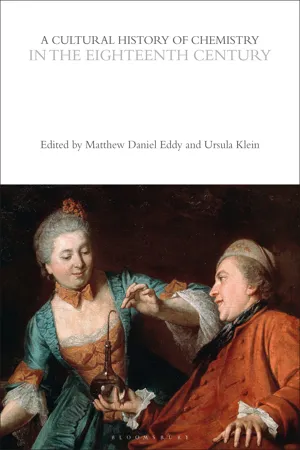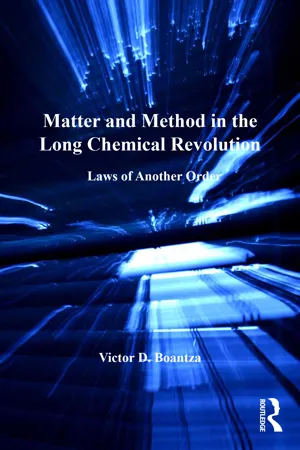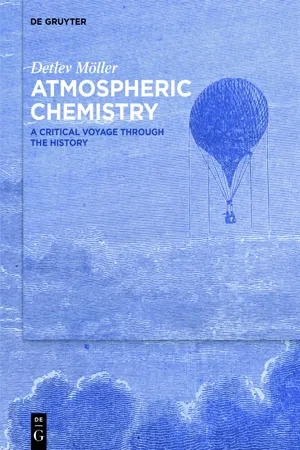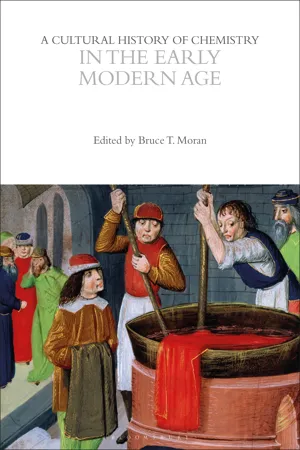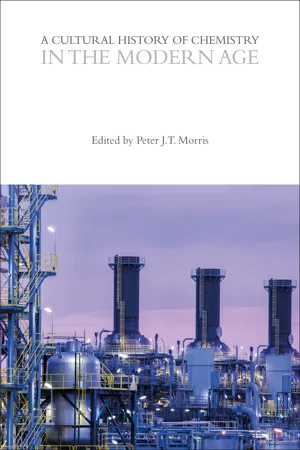Chemistry
History of Chemistry
The history of chemistry traces the development of the science of matter and the changes it undergoes. It has its roots in ancient civilizations such as Egypt and Mesopotamia, and has evolved through various stages including alchemy, the scientific revolution, and the modern era. Key figures like Antoine Lavoisier and Dmitri Mendeleev have made significant contributions to the field, shaping its progress over time.
Written by Perlego with AI-assistance
Related key terms
Related key terms
1 of 4
Related key terms
1 of 3
5 Key excerpts on "History of Chemistry"
- Matthew Daniel Eddy, Ursula Klein, Matthew Daniel Eddy, Ursula Klein(Authors)
- 2023(Publication Date)
- Bloomsbury Academic(Publisher)
Introduction The Core Concepts and Cultural Context of Eighteenth-Century Chemistry URSULA KLEIN AND MATTHEW DANIEL EDDY Before the late seventeenth century, chemistry was neither a professional occupation nor an academic discipline. Persons recognized as alchemists or chemists (collectively: “chymists”) were individuals scattered over different places and professions. Making a good living as a chymist was achieved mainly at princely courts. Add to this the fact that the medieval and Renaissance university did not include chymistry in its curriculum. After the introduction of medical chymistry in the late sixteenth and seventeenth centuries, several universities included courses on chymistry in their medical curricula. This made it possible for professors of medicine, physicians, and apothecaries to earn money by preparing chemical remedies. But how did chymistry expand from being a philosophy and an art practiced in a variety of local contexts into a fully fledged chemical discipline? This introductory chapter answers this question by presenting an overview of the core concepts and cultural context that enabled chemists to transform chemistry into an independent discipline that systematically collected local knowledge about a broad range of material substances and ways of their change, and how it further engendered new empirical and theoretical knowledge. INSTITUTIONALIZATION OF CHEMISTRY AND THE FORMATION OF CHEMICAL COMMUNITIES Before the late seventeenth century, the book, in printed or manuscript form, was a central mode of communication through which chemical knowledge was accumulated, structured, and socially transmitted. Many historians see Andreas Libavius’ Alchemia, published in 1597, as the first chemical textbook that presented the terrain of chemical knowledge in a comprehensive and systematic way (Hannaway 1975)- eBook - ePub
Matter and Method in the Long Chemical Revolution
Laws of Another Order
- Victor D. Boantza(Author)
- 2016(Publication Date)
- Routledge(Publisher)
Introduction
Historiography
There are good reasons why the history of science tends to focus on successes rather than failures, on the “winners” rather than the “losers,” on the drama of the revolution—climactic shifts in science lend themselves to self-contained accounts that command attention. However, the longstanding focus on scientific revolutions has overlooked underlying currents over longer timeframes, across multiple historical locales and intellectual spheres, resulting in a discontinuous narrative of the emergence of modern science. Nowhere is this problem clearer than in the account of how modern chemistry emerged, an account that is dominated by two separate and distinct revolutions: the seventeenth-century scientific revolution, which marks the dawn of modern physics and experimental science; and the chemical revolution of the late eighteenth century, to which the origin of modern chemistry is exclusively attributed. It is becoming increasingly evident that the rise of modern chemistry cannot be explained using the revolution-centered narrative alone. This approach, to name some of its drawbacks, tends to downplay historical and conceptual continuity; it emphasizes theory over practice, since practice is typically slower to change than theory; and it draws our attention to the revolutionaries, although we can often learn more from the scientists whose contributions had a subtler impact over longer periods.Since Thomas Kuhn’s Structure of Scientific Revolutions (1962), the seventeenth-century scientific revolution and especially the eighteenth-century chemical revolution have been widely recognized as the two greatest transformations of early modern science.1 In these sweeping substitutions of one scientific paradigm for another, Newton and Lavoisier stand as archetypal scientific revolutionaries alongside only Copernicus and Einstein. Yet the two revolutions are rarely considered together. The rise of modern physics and the emergence of modern chemistry have been traditionally viewed as two distinct and unconnected episodes.2 Newton modernized celestial and terrestrial physics, invented calculus, and introduced universal gravitation in his Principia Mathematica of 1687. A century later, Lavoisier’s Elements of Chemistry - eBook - ePub
Atmospheric Chemistry
A Critical Voyage Through the History
- Detlev Möller(Author)
- 2022(Publication Date)
- De Gruyter(Publisher)
1962 ).1.3.5.1 From alchemy to quantum chemistry
Alchemists knew that heat was the power to proceed conversions of substances; using alchemistic symbols and names, chemical reaction diagrams, are first known from the French iatrochemist Jean Beguin (about 1520–1620), in his “Tyrocinium Chymicum ”, a set of chemistry lecture notes started in 1610 in Paris and later published by several editors (first 1634 in Wittenbergæ176 by C. Bergeri, 620 pp.). Boyle first combined in his studies on gases (relation between amount, pressure, and temperature) alchemy with the exact discipline physics. He introduced the scientific terms element, chemical compound and chemical reaction. In 1757, Scottish physician and chemist William Cullen (1710–1790), building on the new science of affinity chemistry, launched in 1718 by French chemist Etienne Geoffroy (1672–1731), pioneered the use of reaction arrow (→) to express or characterize the “elective” affinity preference (affinity force) of the reacting species. The next development of chemical equation theory, the use of reaction diagrams and affinity tables comes from Cullen’s student Joseph Black, in 1775 from the Swedish chemist Tobern Bergman (1735–1784), and in 1782, Antoine Lavoisier, who was employed, it seems for the first time, a “horizontal” (modern) mathematical-stylized (+, −) representation of chemical reactions, using ratios and products; moreover, in 1787 he was the first to make the first chemical equation with the sign of equality (=); Hartley (1971 , p. 82). In about 1884, the Dutch physical chemist Jacobus van’t Hoff - Bruce T. Moran, Bruce T. Moran(Authors)
- 2023(Publication Date)
- Bloomsbury Academic(Publisher)
In the sixteenth and seventeenth centuries, no science of chemistry in today’s sense yet existed. There was no modern conception of a chemical element, nor of elective affinities, nor of chemical combination. Common laboratory ingredients were not well standardized and canons of experimental evidence were not firmly established. The domains of theoretical and practical knowledge remained loosely knit together, and an institutional framework for carrying out chemical research and communicating chemical discoveries was only beginning to emerge. Chemical investigators often communicated using language that was so obscure that sometimes even fellow experts could not hope to extract a definitive sense. Nonetheless in 1500 Europeans already possessed much chemical knowledge, and by 1700 they possessed a great deal more. More significantly, over the two intervening centuries the social and cultural patterns of knowledge production and dissemination developed in ways that would, in the centuries that followed, make the development of a modern science of chemistry possible.The word “science,” in the sixteenth and seventeenth centuries, simply meant systematic knowledge; and “knowledge,” then as now, could be construed in two general ways. Philosophers hold that for something to count as knowledge it must really be true (Feldman 2003). Sociologists argue that when beliefs are systematically arranged and offered within a given cultural context, they too function as knowledge (Berger and Luckmann 1966). Historians of chemistry can profitably apply both perspectives. On the one hand, by our own lights, sixteenth- and seventeenth-century chemical investigators knew much, and we can apply modern scientific understanding to aid us in appreciating not only what they were able to discover, but also how they set about doing it (Principe 1990; Principe 2000; Newman and Principe 2002). On the other hand, the beliefs and practices of the period that are no longer considered scientific or credible today are also relevant to constructing a full historical picture.- Peter J. T. Morris, Peter J. T. Morris(Authors)
- 2023(Publication Date)
- Bloomsbury Academic(Publisher)
CHAPTER ONEMARY JO NYE INTRODUCTIONTheory and Concepts: Stability and Transformation in Chemical Problems and Explanation 1914 to the PresentThe starting point for this chapter is 1914, the tragic watershed year of modernity that separated the nineteenth century from World War I and its aftermath.1 Chemists fought and worked in that war, and they brought chemistry under a new kind of scrutiny and fame, if not sometimes infamy, in what some have called the “chemists’ war.” Praised in the past for their contributions to science and to industry, chemists now were publicly recognized and often vilified for their role in military operations (Johnson 2010; Freemantle 2014; Friedrich 2017). At the war’s end, most chemists returned to their laboratories in university, government, or industry settings, often taking up research from where they had left it in 1914.A great deal had been achieved in the century before 1914. Chemistry had become a fairly well demarcated discipline by the 1830s, separate from natural philosophy (physics) and natural history (biology, mineralogy, and geology), although still having ties to these fields (Klein and Lefèvre 2007; Klein 2016). During the course of the nineteenth century, organic chemistry became the dominant subdiscipline within chemical science, alongside mineral (or inorganic) chemistry. Physical chemistry began emerging as a significant new field bringing spectroscopy, thermodynamics, and reaction dynamics into chemistry (Ihde 1964; Laidler 1993). A great deal of nineteenth-century chemistry persisted throughout the twentieth century at the core of the chemist’s repertoire. Reflecting on that fact, the Harvard physical and theoretical chemist Dudley Herschbach commented in an interview in 2012 (my emphasis) that: “… for problems that are really interesting to true chemists
Index pages curate the most relevant extracts from our library of academic textbooks. They’ve been created using an in-house natural language model (NLM), each adding context and meaning to key research topics.
Explore more topic indexes
Explore more topic indexes
1 of 6
Explore more topic indexes
1 of 4
